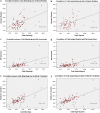Does lateral vertebral translation correspond to Cobb angle and relate in the same way to axial vertebral rotation and rib hump index? A radiographic analysis on idiopathic scoliosis
- PMID: 21308473
- PMCID: PMC3176709
- DOI: 10.1007/s00586-011-1702-0
Does lateral vertebral translation correspond to Cobb angle and relate in the same way to axial vertebral rotation and rib hump index? A radiographic analysis on idiopathic scoliosis
Abstract
The deformity in idiopathic scoliosis (IS) is three dimensional in nature and effective correction involves all three planes. Even though the vertebral translation (VT) is an accepted element in the deformity along with vertebral rotation(VR) as reported by Asher and Cook (Spine (Phila Pa 1976) 20(12):1386-1391, 1995), Kotwicki et al. (Study Health Technol Inf 123:164-168, 2006) and Kotwicki and Napiontek (Pediatr Orthop 28(2):225-229, 2008), rib hump (rib hump index (RI)) and Cobb angle as reported by Aaro and Dahlborn (Spine (Phila Pa 1976) 6(6):567-572, 1981), it was assumed that VT was represented by adequately by Cobb angle and it was not analysed individually. We hypothesized that the Cobb angle and the VT measured in axial plane on CT scan and may not represent the same measurement and factors like coronal plane vertebral tilt,VR and vertebral deformation might affect them in different ways. Hence, VT should be considered as a separate variable and its relationship with VR, RI and Cobb angle should be investigated. Since the newer implants depend on curve translation and derotation for correction studying the role of VT and the relationships is important. VT, VR and RI were measured in CT scans of 75 patients with IS and correlated with Cobb angle. Regression analysis was used to identify the influence of the variables on each other. All the variables significantly correlated with one another but the correlation of Cobb and VT is not perfectly linear and it cannot be used to represent VT. VT influences RI much more than Cobb angle or VR. VT, therefore, merits further study treating it as an independent variable.
Figures





Similar articles
-
Why Is There Always a Remnant Rib Hump Deformity after Spinal Operations in Idiopathic Scoliosis: Aetiological Implications and Recognition of the Proper Rib Level for Costoplasty.Children (Basel). 2023 Oct 17;10(10):1697. doi: 10.3390/children10101697. Children (Basel). 2023. PMID: 37892360 Free PMC article. Review.
-
Evaluating the Change in Axial Vertebral Rotation Following Thoracoscopic Anterior Scoliosis Surgery Using Low-Dose Computed Tomography.Spine Deform. 2017 May;5(3):172-180. doi: 10.1016/j.jspd.2016.12.003. Spine Deform. 2017. PMID: 28449960
-
Vertebral rotation and thoracic torsion in adolescent idiopathic scoliosis: what is the best radiographic correlate?J Spinal Disord Tech. 2005 Apr;18(2):139-47. doi: 10.1097/01.bsd.0000159033.89623.bc. J Spinal Disord Tech. 2005. PMID: 15800431
-
Antagonistic role of vertebral translation against vertebral rotation in the spontaneous postoperative modulation of the anterior chest wall contour in thoracic idiopathic scoliosis.Spine (Phila Pa 1976). 2013 Sep 1;38(19):E1201-8. doi: 10.1097/BRS.0b013e31829e0bf9. Spine (Phila Pa 1976). 2013. PMID: 23759807
-
The Double Rib Contour Sign (DRCS) in lateral spinal radiographs: aetiologic implications for scoliosis.Stud Health Technol Inform. 2002;88:38-43. Stud Health Technol Inform. 2002. PMID: 15456003
Cited by
-
Biomechanical Morphing for Personalized Fitting of Scoliotic Torso Skeleton Models.Front Bioeng Biotechnol. 2022 Jul 19;10:945461. doi: 10.3389/fbioe.2022.945461. eCollection 2022. Front Bioeng Biotechnol. 2022. PMID: 35928945 Free PMC article.
-
Why Is There Always a Remnant Rib Hump Deformity after Spinal Operations in Idiopathic Scoliosis: Aetiological Implications and Recognition of the Proper Rib Level for Costoplasty.Children (Basel). 2023 Oct 17;10(10):1697. doi: 10.3390/children10101697. Children (Basel). 2023. PMID: 37892360 Free PMC article. Review.
-
Expressing Cobb Angle as Linear Measurement in Scoliosis and Its Significance: A Clinical and Geometrical Analysis of Scoliosis.Korean J Spine. 2017 Dec;14(4):139-142. doi: 10.14245/kjs.2017.14.4.139. Epub 2017 Dec 31. Korean J Spine. 2017. PMID: 29301173 Free PMC article.
-
Predicting preoperative pulmonary function in patients with thoracic adolescent idiopathic scoliosis from spinal and thoracic radiographic parameters.Eur Spine J. 2021 Mar;30(3):634-644. doi: 10.1007/s00586-020-06552-y. Epub 2020 Jul 30. Eur Spine J. 2021. PMID: 32734473
-
Magnetically controlled growing rods in the management of early onset scoliosis: a systematic review.J Orthop Surg Res. 2022 Jun 11;17(1):309. doi: 10.1186/s13018-022-03200-7. J Orthop Surg Res. 2022. PMID: 35690867 Free PMC article.
References
-
- Grivas TB, Samelis P, Chadziargiropoulos T, Polyzois B. Study of the rib cage deformity in children with 10 degrees-20 degrees of Cobb angle late onset idiopathic scoliosis, using rib-vertebra angles–aetiologic implications. Study Health Tech Inf. 2002;91:20–24. - PubMed
-
- Grivas TB, Dangas S, Polyzois BD, Samelis P. The double rib contour sign (DRCS) in lateral spinal radiographs: aetiologic implications for scoliosis. Study Health Tech Inf. 2002;88:38–43. - PubMed
MeSH terms
LinkOut - more resources
Full Text Sources
Other Literature Sources
Medical

